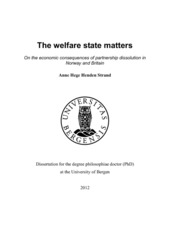| dc.description.abstract | Recent sociological observations have indicated that unstable family relations and lone parenthood present new social risks to society, posing a challenge to the welfare state and threatening to increase gender inequality. Several cross-national studies from the US and various European countries have documented that the economic consequences of partnership dissolution are more severe for women than men, indicating that divorce and separation are significant contributors to gender inequality in society. Norway had not previously been included in any such cross-national study, yet research conducted on Norway had indicated that there were few income differences between women and men after partnership dissolution there. This study had two main purposes; first, to introduce Norway into a cross-national comparison investigating whether Norway would be a country with lower levels of gender inequality in post-dissolution incomes, and second, to explore the role the welfare state potentially plays in reducing gender income inequality in relation to partnership dissolution. A case-study approach was applied where Norway was compared with Britain, a country with a well-documented situation of gender income inequality amongst separated persons. Analyses of individual level, longitudinal data were carried out, and different income measures and methodological designs were applied in order to analyse the extent to which partnership dissolution acted as an event leading to a downward shift in household income. This methodological approach was used to argue that dynamic, quantitative research is particularly suited to examine the links between life course changes, gender inequality, and the welfare state. Crucially, this study found that partnership dissolution did not lead to income differences between women and men in Norway, however, in Britain partnership dissolution lead to a larger income gap between women and men. Furthermore, this study found that women and men differed in their economic dependencies following dissolution. Men relied to a larger extent on labour income after dissolution than women did. Norwegian women depended equally on labour market income and on economic transfers to secure their incomes after dissolution. British women were particularly vulnerable, since they had a weaker connection to the labour market than did men and heavier caring responsibilities than men, but at the same time, received little in terms of economic transfers. This significantly increased their poverty risks as a consequence of partnership dissolution. In addition, this study revealed how family policies had shifted over time in both counties to become closer to an ‘adult worker’ norm. However, despite policy developments in the two countries broadly following the same direction, large differences in welfare state institutional systems between the two countries were demonstrated. Norway had a better system for income protection than Britain, largely based on policies that economically compensated parents for having children in the household. This reduced the economic risks of lone mothers in Norway. Although partnership dissolution rates were similar in the two countries studies, the difference in welfare state support was identified as the most important factor in terms of generating cross-national variance in the economic situation of women and men after partnership dissolution. A key finding was thus that the welfare state matters for reducing gender income inequality. | en_US |
